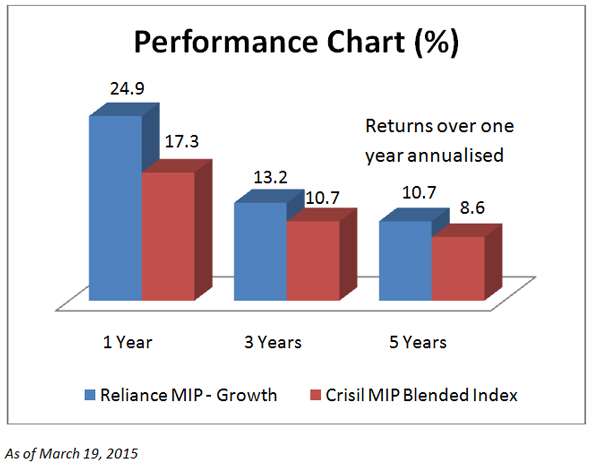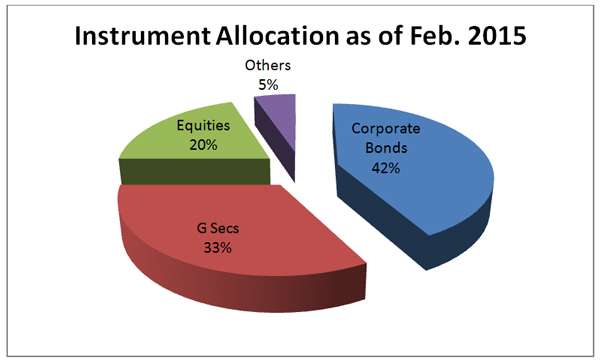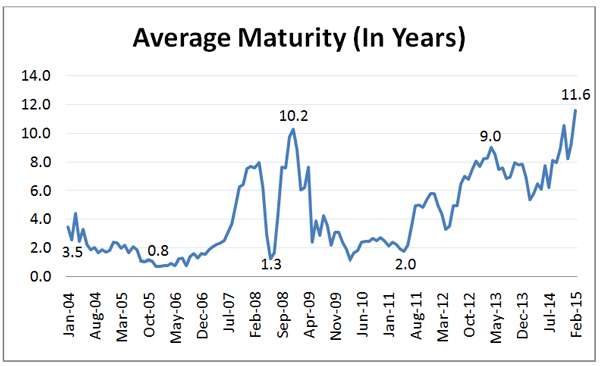If you're a first-time investor in mutual funds, or if you who want a bit of equities in your portfolio, then Reliance Monthly Income Plan (MIP) is a good option.
With a return of 10.7 per cent annually in the last five years, and around 11.4 per cent since its launch in January 2004, this debt-oriented fund is amongst the top performers in the monthly income scheme / debt-oriented category. This return is also a good three percentage points over its benchmark, Crisil MIP Blended Index.
With a higher average portfolio maturity compared with a few of its peers, the fund's debt portfolio may deliver over the next 18 months when more interest rate cuts happen.
Suitability
If you are a first time investor in equity, then you may consider to invest in Reliance MIP. This fund is also a good choice if you wish to diversify your equity-laden portfolio with some debt.
If you can stomach risks that are some what higher than holding pure debt funds, and if you expect slightly better returns than that offered by the latter, then Reliance MIP is a good option.
Firstly, even though it is a debt-oriented fund, Reliance MIP can invest up to 20 per cent in equities. That means in times of steep equity declines, the fund can slip into negative returns in the short term. However, over a three-year period, Reliance MIP has never given negative returns to its investors.
Secondly, even among the category of debt-oriented funds, Reliance MIP can be risky as it tends to take aggressive debt calls in anticipation of interest rate movements. Still, thus far, it has compensated investors with returns for the risk assumed. Though the fund is not obligated to declare dividend regularly, going by its dividend track record, you can expect it to provide you with some additional income stream. Reliance MIP also has a good record of declaring steady and high quantum of dividends for those who opt for pay out.
Performance
Reliance MIP tops the five-year and ten-year chart of debt-oriented MIP funds (which have around 20 per cent average equity exposure). The fund's three-year rolling return, since its inception, is an average 11 per cent compounded annually. During any three-year period, the fund has never given negative returns to its investors. That means, irrespective of when you invested, your average three-year returns would have been around this figure.
HDFC Multiple Yield Fund 2005 comes close to this number on a rolling return basis. But it is to be noted that HDFC Multiple Yield Fund 2005, often times, goes over 20 per cent on equities. Reliance MIP sticks to its mandate and never went beyond the 20 per cent cap in equity since its inception.
Among the universe of MIP funds, Reliance MIP also scores well on a risk-adjusted basis too (as measured by the Sharpe ratio). It would have delivered an Internal Rate of Return (IRR) of 12 per cent annually had you invested through the Systematic Investment Plan (SIP) route from the fund's inception. Lump sum returns over this period were 11.4 per cent.
Reliance MIP has had its down periods too. It did not have a great period between late 2007 and the first half of 2008. Besides being hurt by the equity downfall in early 2008, the fund had anticipated an interest rate decline a little too early. As a result, it suffered negative returns in the first quarter of 2008 and remained lacklustre up to mid-2008. But to its credit, it made up by gaining 14 per cent in the December 2008 quarter when interest rate cuts began. This illustrates how the fund had delivered in the end, in spite of taking risky calls.
Portfolio
The fund invested 80 per cent of its portfolio in debt instruments. Reliance MIP currently sports a debt portfolio with an average maturity of 11.6 years. That's far higher than the maturity profiles of other MIPs. However, if interest rate cuts act in its favour, then the fund can deliver more.
Reliance MIP's debt component is very actively managed; equal focus has been given to accruals and capital appreciation through active duration calls. The fund has one third of its assets in government securities and about 42 per cent in corporate bonds. Majority of the portfolio is AAA and AA rated. It has 18.5 per cent exposure in AAA rated bonds and 25 per cent exposure in AA rated bonds.
Reliance MIP has reasonably diversified its equity portfolio by holding 24 stocks over 15 different sectors. It follows the multi cap style. Historically, the fund has taken 10 per cent average exposure in large-cap stocks (above Rs 10,000 crore market capitalisation) and 5 per cent each in mid-cap (Rs 2,000-10,000 crore market cap) and small-cap stocks (below Rs 2,000 crore).
Reliance Jio Infocomm Ltd., IDBI Bank Ltd., Reliance Utilities & Power Pvt. Ltd., DLF Promenade Ltd. and Jindal Saw Ltd. are its top holdings among corporate debentures. Federal Mogul Goetze, Sundaram-Clayton, HDFC Bank, Axis Bank and TV18 Broadcast are its top equity picks.
The fund is managed by Amit Tripathi and Sanjay Parekh.
*Mutual Fund investments are subject to market risks, read all scheme related documents carefully. Past performance is not indicative of future results.
Best Tax Saver Mutual Funds or ELSS Mutual Funds for 2015
1.ICICI Prudential Tax Plan
2.Reliance Tax Saver (ELSS) Fund
3.HDFC TaxSaver
4.DSP BlackRock Tax Saver Fund
5.Religare Tax Plan
6.Franklin India TaxShield
7.Canara Robeco Equity Tax Saver
8.IDFC Tax Advantage (ELSS) Fund
9.Axis Tax Saver Fund
10.BNP Paribas Long Term Equity Fund
You can invest Rs 1,50,000 and Save Tax under Section 80C by investing in Mutual Funds
Invest in Tax Saver Mutual Funds Online -
For further information contact Prajna Capital on 94 8300 8300 by leaving a missed call
---------------------------------------------
Leave your comment with mail ID and we will answer them
OR
You can write to us at
PrajnaCapital [at] Gmail [dot] Com
OR
Leave a missed Call on 94 8300 8300
---------------------------------------------
Invest Mutual Funds Online
Download Mutual Fund Application Forms from all AMCs


